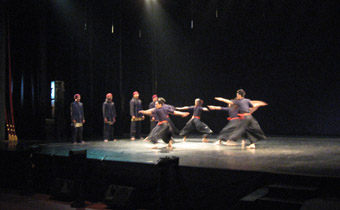 |
Seruan photo Phalla San |
This moment is a crucial, symbolic part of the dance, blurring the boundaries between singers and dancers and heightening the spiritual mood. The singers and the dancers become one in a trance-like rhythmic state.
In another scene three people lie down in the centre, right and left of the stage. The central one is still as five chanting male singers surround him. He seems trapped, helpless, as though he cannot bear the weight of his “sins”—as the program indicates this work is about "the need for the return of lost conscience." As the chant grows stronger, the other dancers rise up, but the first man does not move. The chanting perhaps reminds him of the causes for his state and what he must do to get back on the right path. This and the trance-like episode are the most captivating moments in Seruan.
Seruan elaborates the concern of the choreographer, Gusmiati Suid who died in 2001, about the dissolution of tradition and the disappearing influence of religion. Seruan is literally a calling to people to go back to their roots and not lose themselves to modernization. This dance work was revived for the opening program of the 10th Indonesian Dance Festival.
Along with Sardono W Kusumo and several others, Gusmiati Suid is one of the pioneers of contemporary dance in Indonesia. She uses the vocabulary of traditional West Sumatran dances in making her works, often combining them with Randai, a traditional theater form where the sound for a work is usually produced entirely with voice, hand clapping and the movement of the singers. Gusmiati Suid also included in her choreography aspects of Pencak Silat, a traditional martial arts with very dynamic movement, as well as Rantak, a folk dance originating in Minangkabau. This is why martial art footwork, with the legs widely spaced and hands moving swiftly as in combat, is seen from time to time in Seruan.
As well, the dancers often raise their hands, palms open towards the sky, as in Moslem prayer, symbolizing an appeal to God for the granting of wishes.
The dance also included elements of West Sumatran tradition. In the music we often hear the sound of Saluang in the background—a kind of traditional flute played using the pentatonic scale. For those who have been to the area of West Sumatra, the sound would remind them of the great mountainous area, the cool air and the vast paddy fields spread throughout the region.
Seruan ended optimistically. A man and woman take centrestage: both raising their hands as if towards God, answering to the calling of conscience and once again reconnecting with the highest form of being.
Seruan, choreographer Gusmiati Suid, music and vocal arrangement Piter Slayan, Syahrial, Graha Bhakti Budaya, Taman Ismail Marzuki, Jakarta, 10th Indonesian Dance Festival, June 15
Devi Fitria is a Jakarta-based journalist who works for the Indonesian art magazine ARTI and an online history magazine, HISTORIA:
© Devi Fritrai; for permission to reproduce apply to [email protected]








 back
back